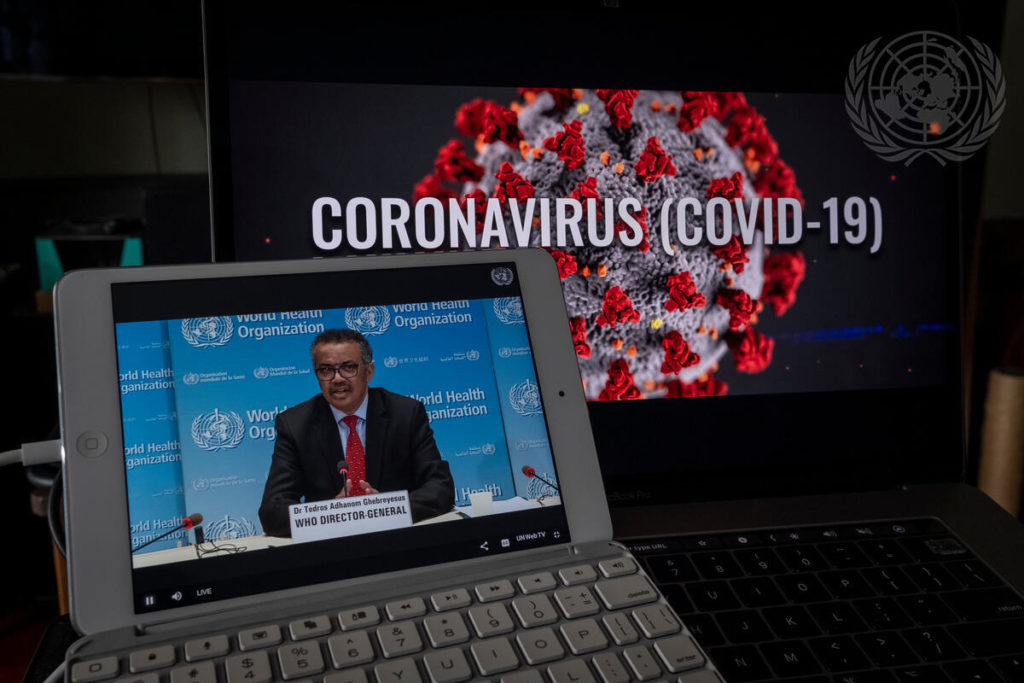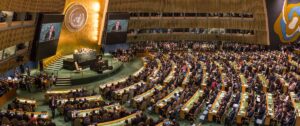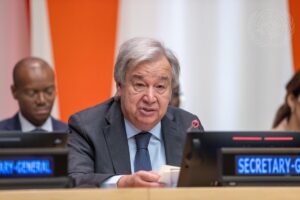The Biden Administration has launched a new course on global health, issuing a National Security Decision Directive in its first week, returning to the table at the World Health Organization (WHO), and committing to join the international vaccine consortium, COVAX. Its American Rescue Plan, refined and enacted by Congress on March 10, 2021, included $10.75 billion for international COVID response. The Biden Administration’s Fiscal Year (FY) 2022 Budget Request released May 28, 2021 calls for $10 billion for global health programs. That includes a five-fold increase in global health security programs ($1 billion) as part of a 12% increase in non-defense international affairs spending from FY21 enacted levels. The Budget Request “includes $250.0 million funded through the State Department’s Global Health Program to support a new health security financing mechanism, which would be developed alongside U.S. partners and allies, to ensure global readiness to respond to the next outbreak.” At the G-20 Global Health Summit and World Health Assembly in May, U.S. officials called such a mechanism’s rapid launch (as a higher priority than a pandemics treaty proposed by others).
The United States role is central to international funding streams and effective health policy. An appraisal here of how the U.S. finances various health security-relevant multilateral bodies by assessment (dues at a set rate), by voluntary contributions (non-dues), by both, and by multi-year pledges (subject to annual appropriations) indicates that the U.S. should:
- Enlarge overall global health investments to address persistent and emerging pandemics. As outlined in a recent study, genuine U.S. health security depends not only on domestic pandemic preparedness but on partnering with low- and middle-income countries (LMICs) on their health security. Health security will elude LMICs as long as AIDS, tuberculosis (with menacing multi-drug resistant variants) and malaria still claim millions of lives as the world’s deadliest infectious diseases. New waves and mutating variants of COVID-19 in African and other LMICs, also threatening a decade of progress against HIV, TB and malaria, preview the challenges of inevitable future pandemics. The U.S. can afford and must afford to double current global health investments within five years.
- Provide dependable funding to multilateral health entities. This includes both core funding to maintain organizations’ capabilities and reliable programmatic funding to allow long-term planning. In particular, the U.S. should pay its assessed dues fully on a timely basis. It should limit withholdings and funding-conditionality, which have grown counterproductive since the 1990s, with the possible exception of provisions designed to incentivize other donors’ contributions.
- Integrate the most agile, high-value existing multilateral partnerships into new global health security structures. Carefully assessing how ad hoc multilateral partnerships vary in their impact, agility, comparative advantages, and need for reforms and new mechanisms, the U.S. should leverage successes and good models, and avoid duplication and greater siloing of functions.
These steps will enable a new policy framework for making results-oriented investments in local health systems that better meet the needs of communities, engage marginalized populations and civil society as critical partners, identify new threats, and create flexibility to respond when emergencies arise. The key organizations and partnerships that contribute to global health security are the World Health Organization; Gavi; Global Fund to Fight AIDS Tuberculosis and Malaria; Unitaid; UNAIDS; Global Health Security Agenda; Coalition for Epidemic Preparedness Innovations; Access to COVID-19 Tools Accelerator; and COVAX.
The WHO: A Linchpin Dependent on Assessed and Voluntary Funding
The World Health Organization remains the central intergovernmental organization (IGO) pertinent to global health security. Its functions of guidance, standard-setting, and pooling infectious disease surveillance are critical to pandemic preparedness and response.
The WHO, by nature, is highly influenced by its member states which contribute assessed and voluntary funds, and by private sector partners needed to enlarge resources. Voluntary contributions from multilateral, private, and governmental bodies for earmarked uses make up 80% of the WHO budget. The top voluntary donors are the U.S., UK and Germany. The top assessed contributors are the United States (22%), China (12%), and Japan (8.5%). Facing China’s initial opacity about the emergence of COVID-19, the WHO was hesitant to press China as a major member state and funder, for more reliable, real-time information.
WHO reliance on assessments and voluntary contributions heightens the impact of U.S. funding timeliness or withholdings. At a 22% assessment rate, U.S. “dues” have amounted to approximately $120 million in U.S. Fiscal Years (FY) 2016-2020. U.S. annual voluntary contributions in the same timeframe have amounted to $250 to $400 million annually—devoted to specific activities such as polio eradication, food safety, regulation of medicines, and maternal, newborn, and child health programs.
Blaming the WHO for a lack of transparency about COVID-19 due to China’s influence, the Trump Administration in April 2020 froze U.S. assessed and voluntary funding, at first temporarily. In July 2020, the U.S. formally notified the UN it would withdraw from the WHO in July 2021—a one-year period required by a 1948 U.S. law. Despite Trump Administration efforts to divert funding to other organizations, it was prevented from withholding funding from previous fiscal years due to the terms in U.S. cooperative agreements for programs the WHO would implement. As of Summer 2020, the U.S. was $203 million in arrears for assessed contributions to the WHO from calendar years 2018, 2019 and 2020 (i.e., U.S. FY18, 2019, and 2020). The Biden Administration, as it had pledged, paid off those arrears by the end of February 2021.
Health, Political Implications of Withholdings. In the Trump era, stalling or diverting funding for the WHO compounded diplomatic isolation from COVID-19 response mechanisms which the WHO facilitated – squandering assets available for U.S. health security. An article in The Lancet found that an American pullout from the WHO, which the Trump Administration had set in motion, would prevent U.S. access to epidemic tracing for Togo Yellow Fever, Middle East Respiratory Syndrome (MERS) in Saudi Arabia, wild poliovirus and dengue in Brazil, as well as coordination on HIV, TB and malaria worldwide. U.S. defunding would have resulted in diminished operations for the WHO, and a void to be filled by other states—such as China, New Zealand, Germany and Australia – which all publicly pledged to sustain funding when the Trump pullout timetable was announced.
On its first day in office in January 2021, the Biden Administration notified the UN that it would reverse the pullout plan. Thus, the United States was able to disburse past appropriations for FY19 and FY20 being held in two-year accounts (as the Administration announced in February), and FY21 funds in the December 2020 Omnibus appropriation. In March, Congress approved the American Rescue Plan Act, which provided funding for two pandemic response efforts catalyzed by the WHO: the Coalition for Epidemic Preparedness Innovations (CEPI) and Access to COVID-19 Tools Accelerator (ACT-A) (see below). Particularly in a crisis situation, the WHO comparative advantage as primary orchestrator1Tine Hanreider, “WHO Orchestrates? Coping with Competitors in Global Health,” in Kenneth Abbott, et al., International Organizations as Orchestrators (Cambridge: Cambridge University Press, 2015). of other IGOs, as well as states, civil society organizations, the private sector and foundations is crucial. Rather than punish the WHO for not fulfilling roles outside its own comparative advantages (e.g., orchestration, standard-setting and aggregating surveillance), the best U.S. course is leveraging complementary assets for health security needs.
Hybrid Institutions Funded in Multiyear Pledges
Among organizations funded by multi-year pledges, Gavi, the Vaccine Alliance, is a multi-stakeholder partnership valuable for pandemic response, vaccinating 822 million children and averting 14 million deaths since 2000. Gavi received $290 million in U.S. appropriations each year from FY18 to FY21. The United States pledged $1.16 billion over four years at Gavi’s 2020-2023 Replenishment, hosted and generously supported by the UK. Gavi has become a focal point in COVID-19 response, leading the COVAX vaccine facility (see below). A U.S. COVID-19 relief package enacted in December 2020 had only one global element: an additional $4 billion to Gavi for COVID-19 vaccination. Gavi reveals the benefits of no legislative withholdings or conditionality, and the U.S. leading by example as persuasive encouragement of other donors.
The Global Fund to Fight AIDS, Tuberculosis and Malaria is the world’s largest global health financer. With its partners, the Global Fund has saved an estimated 38 million lives from the three leading infectious diseases since 2002. It works by empowering multi-stakeholder committees in-country to submit proposals and implement programs, including a role for civil society and disease-affected populations—albeit in varying degrees and with varying resources available. When reviewed, multiple independent assessments identified the Global Fund’s cost-effectiveness, financial and organizational capacity, and transparency as strengths.
The Global Fund also strengthens local health systems and infectious disease resilience. Pertinent to LMICs’ resilience facing new pandemics, such as Ebola in 2014-2016, the Global Fund committed on average $1 billion per year 2017-2019 and $1.33 billion per year 2020-2022 to bolster health systems. It created a COVID-19 Response Mechanism assisting over 100 countries to address COVID-19 and its disruption of HIV, TB and malaria programs. The Biden American Rescue Plan, the stimulus bill enacted in March 2021, included $3.5 billion for the Global Fund as part of $10.75 billion for international response.
U.S. law limits the U.S. contribution to 33% of the Global Fund’s budget, eliciting burden-sharing. For disbursement, other donors must match the U.S. two to one. The United States appropriated $1.35 billion per year in FY 2015-2019 for the Global Fund, and $1.56 billion in FY20 and FY21. The 15.6% increase in FY20 reflected other major donors making similar increases in the October 2019 Global Fund Replenishment. A conclusion is that a simple incentivizing provision in the form of a very generous 33% cap produces results far more than most legislative limitations on multilateral institutions.
A further lesson is that executive branch pledges provide critical predictability to an organization and other donors. During the Trump Administration, however, that role fell to Congress to voice the U.S. three-year intent at the replenishment meeting.
Founded in 2006, Unitaid also invests in innovations to prevent, diagnose and treat HIV, TB and malaria, and improve access to diagnostics and treatment for HIV co-infections such as hepatitis C and human papillomavirus (HPV). This multi-stakeholder partnership hosted by the WHO, has, like Gavi and the Global Fund, has a key role in Access to COVID-19 Tools Accelerator (see below). U.S. investment in Unitaid has been negligible, however. The U.S. has concentrated instead on spending in this area via the bilateral President’s Emergency Program for AIDS Relief (PEPFAR) and the Global Fund – leaving responsibility to support Unitaid to other primary funders. Unitaid highlights how more predictable pledges help agile multi-stakeholder entities deliver on their mission; as such, the U.S. might fund Unitaid as it does the Global Fund and Gavi.
Voluntarily-Funded Institutions
The Joint United Nations Programme on HIV/AIDS (UNAIDS) is the first multilateral entity devoted to pandemic response, melding UN agencies’ and multilateral development banks’ work on AIDS. It reflects functions needed for all pandemics as a target-setter for detection, therapy and viral suppression; keeper of definitive metrics; and platform for marginalized, affected populations’ voice. Untenable and unpredictable, UNAIDS is funded solely by voluntary contributions for specified purposes with no core support. The U.S. prioritizes the President’s Emergency Plan for AIDS Relief (PEPFAR) and the Global Fund—even as they partner with UNAIDS. Australia, Norway, France, Japan, Italy, Germany and Canada are primary funders.
The Global Health Security Agenda (GHSA) was launched and endorsed by the G7 in 2014 after the SARS, H1N1 influenza, MERS, H7N9 influenza and Ebola outbreaks. It is a forum with 69 member countries (15 on a Steering Committee) along with intergovernmental and non-governmental bodies. It promotes consultation, evaluations of health security capacity, and early warning, but lacks operational means of response without core funding. Championed by President Obama, GHSA was funded on an ad hoc basis by the FY15 Emergency Ebola Appropriation. The Trump Administration stayed engaged but with limited global pandemic preparedness funding. The Biden team seeks to create a funding facility to realize GHSA’s purpose.
Emerging Partnerships Based on Voluntary Funding
New partnerships are growing. A recent addition to the landscape (pre-COVID-19) is the Coalition for Epidemic Preparedness Innovations (CEPI), a partnership between public, private, philanthropic, and civil society organizations launched in Davos in 2017 to develop vaccines for future epidemics. The Biden Administration announced in its first 48 hours its intention to support CEPI, though as yet not a specific funding level. The recent American Rescue Plan Act provided funding for USAID, up to $900 million of which can be contributed to multilateral entities, a portion of which could go to CEPI. As of May 2021, legislation authorizing direct appropriations for CEPI has not been enacted.
The Access to COVID-19 Tools Accelerator (ACT-A) brings together other multilateral entities, philanthropists, and scientific innovators to address four needs: (1) diagnostics (led by the Global Fund and FIND), (2) therapeutics (led by Wellcome and Unitaid), (3) vaccines (led by CEPI, GAVI and WHO), and (4) reinforced health systems (led by the World Bank and Global Fund). Top funders include the UK, Canada, Germany, Norway, and the Bill & Melinda Gates Foundation. These contributors compensate for the Trump Administration holding back from multilateral efforts associated with the WHO. With clear lessons on how a Trump-era lack of U.S. leadership and investment hamstrings pandemic response, the Biden Administration announced it will seek appropriations for ACT-A.
The COVAX Facility is ACT-A’s vaccines pillar—a global risk-sharing mechanism for pooled procurement and equitable distribution of COVID-19 vaccines. Operation Warp Speed spurred fast innovation, but Trump era vaccine unilateralism prioritized speed and proprietary control over collaboration and equity of access for lower income countries or marginalized populations within LMICs. However, the December 2020 $4 billion emergency appropriation for Gavi is being applied to COVAX in ACT-A, and the Biden Administration will disburse it in tranches as other donors make commitments. Executive branch action or simple legislative devices can encourage other donors as “honey” better than the “vinegar” of micromanaging legislative provisions.
ACT-A, CEPI and COVAX have the potential as platforms to have enduring value for pandemic response beyond COVID-19, if they move to predictable rather than ad hoc voluntary funding. A rationalization of disparate entities will be necessary, heightened by the proposal by policy specialists, thoughtful legislators and the Administration of a new global health security challenge fund.
To realize health security resilience soonest and minimize duplication, U.S. financial diplomacy should prioritize scaling existing high-value institutions – like the Global Fund and Gavi – and construct new architectures around them.
Implications and Looking Ahead
In addition to multilateral approaches, U.S. global health security policy must weigh the United States’ current and potential bilateral assets—including the Centers for Disease Control, PEPFAR, the President’s Malaria Initiative (PMI), USAID global health programs, or a new office for pandemic preparedness proposed in bipartisan Senate legislation. They can and must be coordinated with invaluable multilateral assets, as robust PEPFAR and PMI collaboration with the Global Fund demonstrate.
By prioritizing health security over polarization, the Biden Administration and Congress can take action to renew engagement with multilateral organizations, including the WHO. The U.S. return to the world stage can be a catalyst for outcomes-driven global health investment by donors and LMICs themselves.
How to achieve this approach? First, the United States should address persistent and emerging pandemics by paving a path to double annual U.S. global health funding over five years. Second, to allow for strategic planning, the United States should provide more dependable funding. That includes eschewing withholdings and forms of conditionality which isolate the U.S. more than they improve health outcomes. In addition to paying assessed dues on time and in full, making predictable pledges to agile multistakeholder entities is a particular sweet spot for U.S. investment. And third, U.S. diplomatic leadership is essential to better weave individual initiatives into a strengthened global health security architecture. As such, the U.S. should back new multilateral mechanisms to finance LMICs’ health systems and health security which build up and build upon the most effective institutions and models, rather than compound complexity and siloing of functions which LMICs must navigate.
U.S. financial diplomacy based on these priorities would take fullest advantage of multilateral partnerships as impact-multipliers for both global and U.S. health security.
Photo Credit: UN Photo/Loey Felipe
About the Author
Mark P. Lagon, Ph.D. is Chief Policy Officer at Friends of the Global Fight Against AIDS, Tuberculosis and Malaria and Adjunct Professor at the Walsh School of Foreign Service, Georgetown University. He served as Deputy Assistant Secretary of State for International Organization Affairs and co-edited the book, Human Dignity and the Future of Global Institutions.
Notes
- 1Tine Hanreider, “WHO Orchestrates? Coping with Competitors in Global Health,” in Kenneth Abbott, et al., International Organizations as Orchestrators (Cambridge: Cambridge University Press, 2015).




